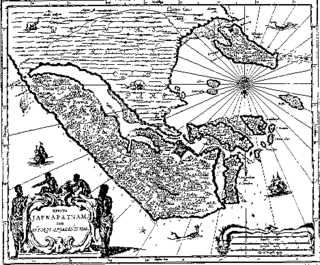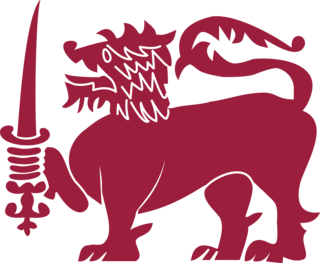
Dominicus Corea also known as Domingos Corea and Edirille Rala, was the son of Don Jeronimo Corea and Anna Corea. Don Jeronimo Corea was also known as Mudaliyar Vikramasinha, Commander-in-Chief of King Mayadunne's army. Jeronimo Corea was assassinated by King Mayadunne's son, Rajasinghe. Dominicus Corea was born in Colombo in 1565. At that time, the Portuguese had colonised Ceylon, and his parents converted to Catholicism.

Karava also Karave, Kara and Kaurawa is a Sinhalese caste from Sri Lanka. The Tamil equivalent is Karaiyar. They are traditionally coastal people occupied in seafaring, fishing and naval warfare.
Deshamanya is the second-highest national honour of Sri Lanka awarded by the Government of Sri Lanka as a civil honour. It is awarded for "highly meritorious service", and is conventionally used as a title or prefix to the recipient's name.
Alagakkonara, also known as Alakeshwara, were a prominent feudal family that provided powerful ministers and military rulers during the medieval period in Sri Lanka. Although some historian say that the family was of Malayali origin, others say they originated from Kanchipuram in Tamil Nadu, India. They arrived in Sri Lanka around the 13th century and naturalized themselves in Sri Lanka. One member of the family is noted for founding the current capital of Sri Lanka, Sri Jayawardenepura Kotte as a fort from which he waged a war against encroaching tax collectors from the Jaffna kingdom in the north. The family lost most of its influence after its leader was taken captive by the Ming Dynasty (Chinese) Admiral Zheng He in 1411.

Rajasinghe I was a king of the Kingdom of Sitawaka. He is known for his extreme bravery and patriotism. Born as Tikiri Bandara to King Mayadunne of the Kingdom of Sitawaka, the name "Rajasinha" was given to him after a fierce battle against Portuguese forces. Rajasinha means the King of Lions.
Ethirimanna Cinkam was the penultimate ruler of the Aryacakravarti line of Kings of the Jaffna Kingdom in northern Sri Lanka. He came to power due to the second Portuguese expedition led by André Furtado de Mendonça in 1591. In that expedition, the King of Jaffna, Puviraja Pandaram and the father of Ethirimnna Cinkam was killed.

The Portuguese conquest of the Jaffna kingdom occurred after Portuguese traders arrived at the rival Kotte Kingdom in the southwest of modern Sri Lanka in 1505. Many kings of Jaffna, such as Cankili I, initially confronted the Portuguese in their attempts at converting the locals to Roman Catholicism, but eventually made peace with them.

Vimaladharmasūriya I was a king of Kandy from 1590 to 1604. His reputation was built when he successfully repulsed two major Portuguese offensives on Kandy, the Campaign of Danture in 1594 and the Battle of Balana in 1602, in both of which the Portuguese were humiliatingly defeated.

The Kingdom of Sitawaka was a kingdom located in south-central Sri Lanka. It emerged from the division of the Kingdom of Kotte following the Spoiling of Vijayabahu in 1521, and over the course of the next seventy years came to dominate much of the island. Sitawaka also offered fierce resistance to the Portuguese, who had arrived on the island in 1505. Despite its military successes, Sitawaka remained unstable, having to contend with repeated uprisings in its restive Kandyan territories, as well as a wide-ranging and often devastating conflict with the Portuguese. Sitawaka disintegrated soon after the death of its last king Rajasimha I in 1593.

A Bandâra was a Great Officer in the Council of State in the Sinhalese Kingdoms of premodern Sri Lanka. A Bandâra was the sons of a chief in the Sinhala Kingdom.
The Battle of Mulleriyawa in 1559 was a battle and a part of the Sinhalese–Portuguese War. It was one of the most decisive battles in Sri Lankan history and considered as the worst defeat of Portuguese during that period. According to local chronicles the marshlands of Mulleriyawa turned red with blood after the annihilation of the Portuguese. With this victory Sitawaka emerged as a military power which able to challenge the Portuguese expansion.

Portuguese Ceylon was the control of the Kingdom of Kotte by the Portuguese Empire, in present-day Sri Lanka, after the country's Crisis of the Sixteenth Century and into the Kandyan period.
Sēnasammata Vikramabāhu was King of Kandy from 1469 to 1511. Before becoming independent the provinces that made up the Kingdom of Kandy belonged to the Kingdom of Kotte. Vikramabāhu founded the city of Kandy, and during the reign of Parakramabahu VI Kandy became a separate entity seceding from Kotte. He was from the House of Siri Sanga Bo and reigned for 4 decades, setting an example of longevity and stability for the new kingdom. His son Jayavira Bandara was his successor.
Karalliyadde Banḍāra was King of Kandy, who ruled from 1552 to 1582. During his reign Banḍāra publicly embraced Catholicism, brought to the island by the Portuguese. He and his infant daughter princess Kusumāsana Devi fled the kingdom with his retinue. The princess was later baptized by the Portuguese and called Dona Catarina. He succeeded his father Jayavira Bandara as king and was succeeded by his daughter Kusumasana Devi.

Kusumāsana Devi, also known as Dona Catherina, was ruling Queen of Kandy in 1581.
The Siege of Kotte from November 1557 – November 1558 was a battle part of the Sinhalese–Portuguese War. A 50,000 strong Sitawaka army led by King Mayadunne besieged Sri Jayawardenapura Kotte, the capital of Kotte Kingdom for 12 months against a combined force of Portuguese and lascarins led by Captain-major Dom Afonso Pereira de Lacerda. After receiving reinforcements from Mannar, Portuguese made a sally and succeeded in forcing the besiegers to withdraw. This siege marked the beginning of a series of battles between Portuguese and Sitawaka forces, and ultimately ended as Portuguese abandoned Sri Jayawardenapura Kotte in 1565.
Mittasena was King of Anuradhapura in the 5th century, whose reign lasted from 435 to 436. He succeeded Chattagahaka Jantu as King of Anuradhapura. During his reign, the kingdom was invaded by Pandu of The Six Dravidians.

The History of the Kandyan Kingdom in Sri Lanka starts with its foundation in 1476.










